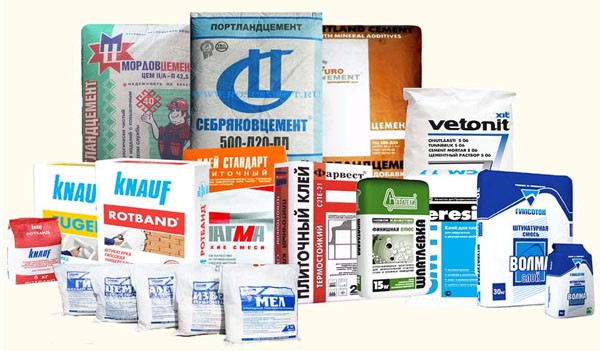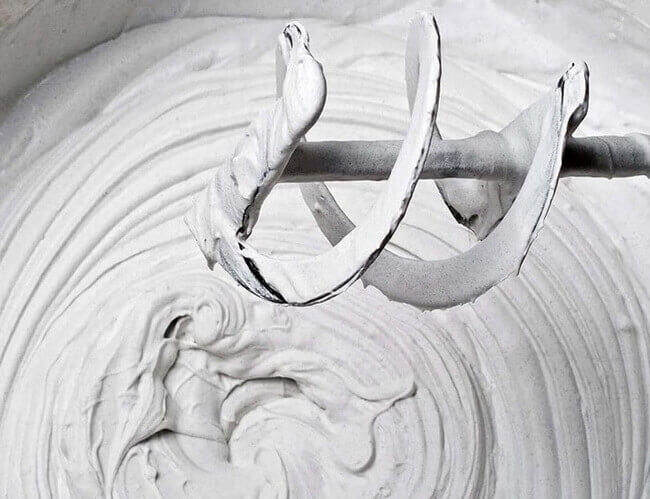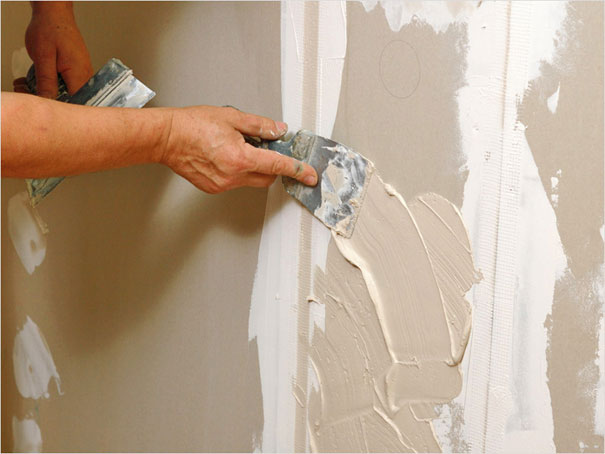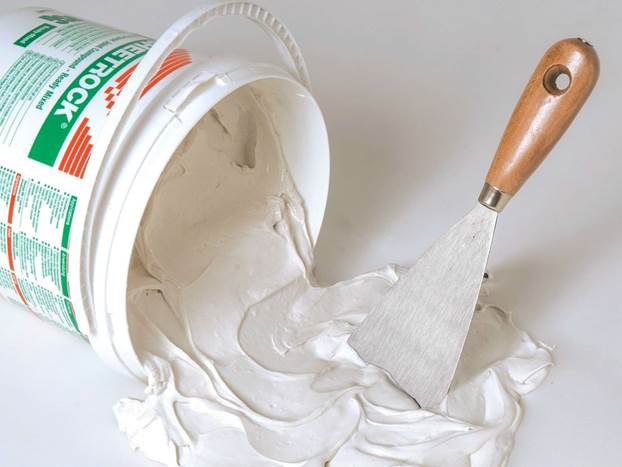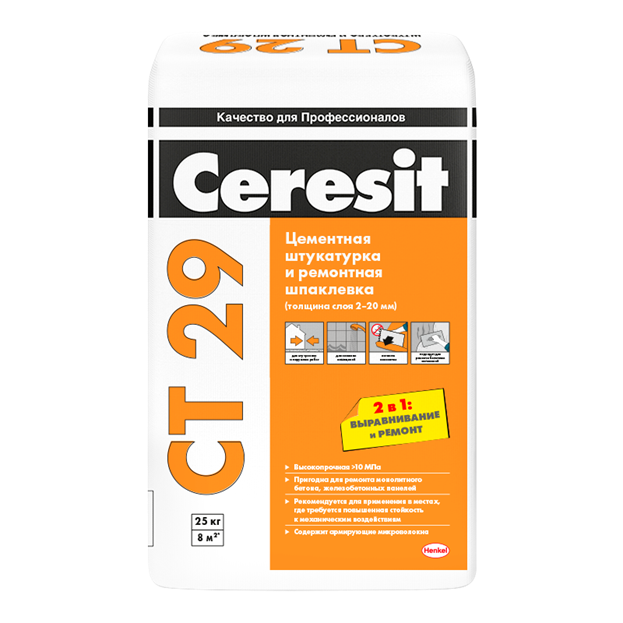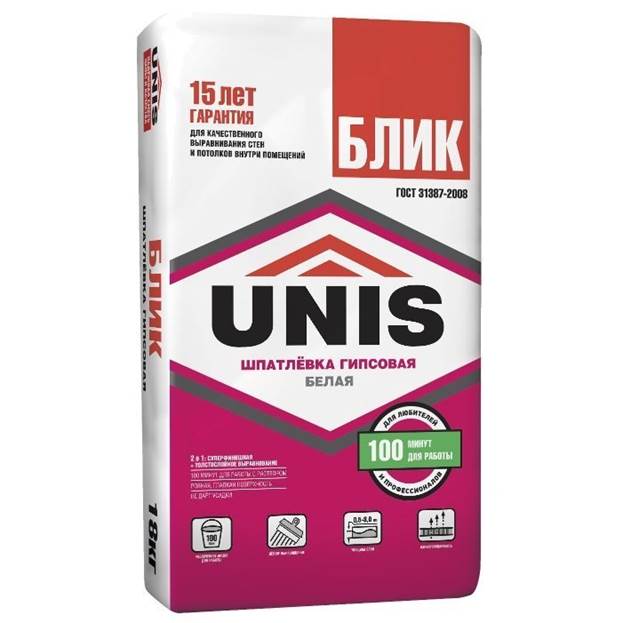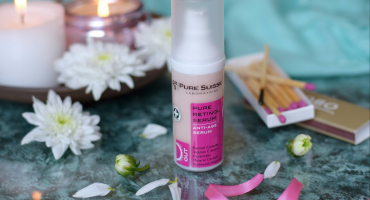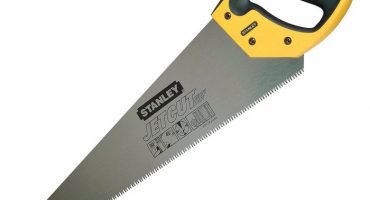Manufacturers offer a wide range of building mixtures, and it is difficult for an unprepared buyer to choose a specific one for walls or ceilings. Of course, when there is a lot of choice, this is good, but on the other hand, it leads people to a slight confusion. In today's article, we will deal with the question of what kind of mixes are generally, how they differ from each other, and which putty is better for specific jobs.
| Category | Name | price, rub. | Short description |
|---|---|---|---|
| Knauf hp | 350/30 kg | This is a gypsum compound used for interior work. Allows you to make a layer with a thickness of 4 to 15 mm. Sold in bags weighing 30 kg. |
| Ceresit ct | 600/25 kg | Brick, concrete and lime surfaces are repaired and leveled by it, both inside and outside the building. | |
| Kreisel | 660/30 kg
| This is a cement-lime fine-grained composition, optimal for plastered and unplastered concrete or brick surfaces |
| Unis flare | 305/25 kg
| This is the best option for a budget finish, made from natural building materials. | |
| Prospectors Finishing | 275/12 kg | It is applied in rooms with a high level of humidity dries in 24 hours. |
| Sheetrock superfinish | 1400/28 kg | All components are already mixed here, so it’s enough for the master to mix the solution and begin finishing work. |
Types of putty as intended
A putty is a creamy mass used for the final leveling of the surface. It serves as a transitional stage before the next procedure - finishing. Current samples are slightly different from older ones, because now the requirements for the quality of the base have increased. Of course, you can always stick wallpapers and hide minor defects on the wall. But, if the surface is painted, then the paint will make scratches or grooves even more visible, therefore, the coating is treated until it becomes even and smooth.
During the finishing work, the walls are first plastered, and then they are putty. Putty building material is applied in 2 stages, so it is customary to classify it according to its purpose.
What types of mixture can there be:
- starting putty;
- finish line;
- universal.
Wall decoration is a step-by-step process in which special compositions are used.
Putties by degree of readiness
According to this parameter, 2 types of putty for walls are distinguished: dry mixes and ready-to-use. They differ, so we will consider their features in more detail.
Dry
They look like ingredients collected in the right proportions. The solution itself is prepared before the start of construction work. These types of putties are sold in bags, which indicate the expiration date and cooking instructions.
Most often, dry mixes are used in puttying. To obtain high-quality putty material, you should clearly follow the cooking instructions and adhere to the proportions of the components and water. When working with a large area, it is not recommended to immediately harvest a large volume of the mixture. This is explained by the fact that after a certain time, the plastic properties of the composition are lost, and it begins to “grasp”. It is recommended to do several batches.
Attention! When choosing dry mixes, pay attention to the price, because for finishing a 3-room apartment you will need more than 1 bag.
There are practically no drawbacks, except that the dry powder leaves dust behind, the mixture itself does not retain its properties for long after kneading and requires clear proportions when cooking.
Ready-to-use putties
The convenience here is that they do not need to be prepared - they are already ready, for which special factory technologies are involved. An additional advantage - they, in comparison with dry mixes, do not lose their properties after a certain time. If necessary, a break is simply taken during the work, and the container in which the mixture is stored is closed. Thanks to the component that does not allow the mixture to set, it retains its properties for a long time. First, the first coat is applied, after it dries - the second, finishing putty. The only thing is that the cost of finished mixtures is higher compared to dry ones, but in the process you don’t have to mess with dust and dirt.
The best putty in composition
The basis of putty mixtures are various compositions, from which operational characteristics change. The greatest demand is cement, gypsum and polymer, although there are other types. Let's get acquainted with the variety in more detail and highlight the features of each.
Cement putty
Cement varieties are in demand during the work on the alignment of internal and external surfaces. 3 ingredients are enough for preparation: water, sand and cement in the form of a binding component.
Helpful information! When mixing ingredients, pay attention to the sand - use clean and large particles, the sizes of which should be from 1.5 to 2.5 mm. When working with fine-grained sand, the wall surface will quickly become covered with cracks.
To bind the components, the required ingredient is water, the optimum temperature of which should be within +20 degrees Celsius. Often this type of putty is used for interior work, and any level of humidity in the room is acceptable. But, you need to remember that the mixture will subsequently shrink, so a repeated processing procedure will be required.
When choosing this composition, also take into account the fact that cement putty can not boast of its elasticity, because of which small cracks can appear on the surface of the walls. After applying the mixture, wait a couple of days, and then grind it. Material should be diluted before starting work, as after a specific time indicated on the package, its properties begin to be lost. On average, the finished mixture can last from 5 to 24 hours.
Attention! If you need to level the wooden surface, cement putty will not work.
Gypsum putty
These are more versatile and practical mixtures used for internal work. This is a good plasterboard putty, which is also suitable for cement and concrete surfaces. If you pay attention to the name, it will become clear that the main component of the mixture is gypsum. Additionally, mineral plasticizing agents and polymer additives are added, which is necessary to improve the properties of the hardened base.
Mineral fillers are quartz sand and marble chips, ground into flour. They make the finished layer resistant to shrinkage and minor mechanical damage. The task of mineral plasticizers is to make the mixture more plastic, which at times makes it easier to work with it. Polymers also make the composition durable and allow it to more effectively adhere to the surface.
Domestic mixtures have a yellowish or pinkish tint, since gypsum for them is extracted in local deposits. In this regard, the best, or rather, the most white putty - Knauf.
| Benefits | disadvantages |
|
|
Polymer putty
A connecting element of this type are polymer components, which expand the scope of the composition and give it excellent performance properties. This putty includes the advantages of the two types described above and has virtually no disadvantages, which is only one here - a high price. Yes, the mixture is not available to everyone, but, by right, it is called universal.
This is a high-strength, quick-drying mixture, which is not afraid of moisture or temperature changes. Advantages come down to excellent elasticity and low consumption. If a mixture having small fractions is used, then the surface will be almost mirrored. Working with her is quite simple, which even a beginner can handle.
| Benefits | disadvantages |
|
|
As a rule, it is used as a putty. That is, with polymer putty, cracks, holes are masked, small areas are leveled, and so on.
Other types of putties
There are other varieties. It all depends on what material is processed and in what conditions it will be used.
Types and features:
- On a glue basis. The ingredients are as follows: drying oil, glue and chalk. The material can easily lie on the walls, filling its structure with cracks and cracks. As a result, a thin but strong layer is formed.
- Oil and glue. It resembles the previous view, but plasticizers and acrylates are added to the composition. As a rule, it smoothes out small defects on those surfaces that have low adhesion: concrete, wood or plastered walls, prepared for painting. Used only for interior use.
- Latex. Components: water, polymer additives and fine aggregate made of calcite sand. It is used for the same tasks as oil-glue putty.
- Acrylic The universal look used during the start or finish. Due to environmental friendliness, biological neutrality and hypoallergenic properties, it is popular for decorating children's rooms.
Choose a putty for the appropriate work.
The best starting putty
These mixtures have this name, since they equalize minor differences, not more than 2 cm. In fact, these are stucco mixtures, but they are applied with the same movements as the putty.
Consider the best starting putties from well-known manufacturers.
Knauf hp
This is a gypsum compound used for interior work. Allows you to make a layer with a thickness of 4 to 15 mm. Sold in bags weighing 30 kg. If the layer is 1 cm, then one package is enough for 4 m2. It is used to level the surface before finishing putty.
| Benefits | disadvantages |
|
|
Price - from 350 p.
Ceresit ct
Brick, concrete and lime surfaces are repaired and leveled by it, both inside and outside the building. Often, ceresites cover cracks, notches, and other defects.
| Benefits | disadvantages |
|
|
Consumption - 7.2 kg per 1 m2, with a layer of 4 mm. Price - about 600 p. for 25 kg.
The scope of its application depends on the selected variety.
The best universal putty
They are called this because of their versatility. Suitable for exterior and interior decoration.
Kreisel
This is a cement-lime fine-grained composition, optimal for plastered and unplastered surfaces made of concrete or brick. Due to its excellent adhesion properties, it is used both externally and internally.
| Benefits | disadvantages |
|
|
Cost - from 660 p. for 30 kg.
Unis flare
This is the best option for a budget finish, made from natural building materials. Domestic putty, as a rule, close up cracks or small defects. Suitable for rooms with a normal microclimate.
| Benefits | disadvantages |
|
|
Cost - from 305 p.
Knauf also has a universal look, which is called Fugen.
The best finishing putty
There are many brands in the rating of putty finishes, but we will focus on two: the domestic Prospectors and Sheetrock superfinish from the USA.
Prospectors Finishing
This is an affordable, but high-quality putty of a domestic manufacturer. This is explained by the fact that modifying additives were added to the gypsum base. Suitable for ceilings and interior rooms.
| Benefits | disadvantages |
|
|
Price - 275 p. for 12 kg.
Sheetrock superfinish
Distributed as ready-to-use. All components are already mixed here, so it’s enough for the master to mix the solution and begin finishing work.
| Benefits | disadvantages |
|
|
Cost - from 1400 p. for 28 kg.
When choosing a putty, you first need to evaluate the conditions in which the coating will be. Living quarters with normal moisture levels are usually treated with gypsum compounds. Many people ask which is better for GCR - again, gypsum, which ideally closes small cracks. For kitchens and bathrooms, cement and universal are recommended.

